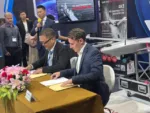The Philippine Navy has officially commissioned its newest warship, BRP Diego Silang (OPV-8301), marking a significant milestone in its naval modernization efforts. Built by South Korea’s Hyundai Heavy Industries (HHI), this offshore patrol vessel (OPV) is the first of six under contract and is expected to bolster maritime domain awareness and sovereignty enforcement across the archipelago’s vast maritime zones.
Strategic Context and Modernization Goals
The acquisition of the BRP Diego Silang is part of Horizon 2 of the Armed Forces of the Philippines (AFP) Modernization Program. This phase emphasizes enhancing naval capabilities for territorial defense and maritime law enforcement amid increasing regional tensions in the South China Sea. The Philippines’ exclusive economic zone (EEZ) spans over 2 million square kilometers—making persistent surveillance and presence a strategic necessity.
In recent years, Manila has prioritized surface combatants and patrol assets to counter illegal fishing, piracy, smuggling, and incursions by foreign vessels into disputed waters such as those near Scarborough Shoal and Reed Bank. The commissioning of OPV-8301 reflects a shift toward more capable platforms with multi-mission flexibility.
Design Origins: HDC-3100 Class from Hyundai
The BRP Diego Silang is based on Hyundai Heavy Industries’ HDC-3100 design—a modern OPV platform optimized for endurance, modularity, and sensor integration. The vessel displaces approximately 3,200 tons full load with an overall length of 94.4 meters and beam of 14.3 meters.
Key performance characteristics include:
- Range: Over 5,500 nautical miles at economical cruising speed
- Endurance: Up to 28 days without resupply
- Crew: Approximately 100 personnel
- Speed: Maximum speed around 22 knots
The hull form emphasizes seakeeping in open ocean conditions while maintaining low radar cross-section through angular superstructure design. The platform includes a flight deck capable of supporting medium naval helicopters such as the AW159 Wildcat or future Philippine Navy rotary assets.
Sensors, Weapons & Mission Systems
The Diego Silang class OPVs are outfitted with baseline mission systems suitable for constabulary roles but designed with space and power margins for future upgrades. According to available specifications:
- Main gun: One Oto Melara 76 mm Super Rapid naval gun on the bow
- Secondary armament: Two remote-controlled weapon stations (RCWS), likely fitted with .50 cal or similar caliber weapons
- Sensors: Integrated navigation radar suite; provisioned for surface search radar; electro-optical/infrared (EO/IR) tracking system mounted above bridge
- C4ISR: Tactical data link capability not yet confirmed; standard bridge-integrated navigation systems installed by HHI
No missile systems are currently installed aboard BRP Diego Silang; however, modular weapon stations amidships suggest future potential for lightweight anti-ship missiles or additional RCWS installations if doctrine evolves toward more heavily armed patrol vessels.
A Modular Platform with Growth Potential
A key feature of the HDC-3100 design is its modularity—both in terms of mission payloads and internal systems architecture. The ship includes a stern ramp for launching RHIBs (rigid-hull inflatable boats), enabling boarding operations during EEZ patrols or interdiction missions.
The flight deck does not include a hangar but can accommodate vertical replenishment operations or temporary helicopter deployments. Below deck spaces are reconfigurable to support humanitarian assistance/disaster relief (HADR) missions or command post functions during joint exercises.
This flexible configuration aligns with Philippine Navy needs across peacetime constabulary duties up to limited wartime roles such as maritime interdiction or forward presence in contested waters.
Status of Fleet Expansion Program
The contract between Hyundai Heavy Industries and Manila was signed in June 2022 under a ₱30 billion (~$550 million USD) deal covering six OPVs. Construction began in earnest in late 2023 after finalizing financing arrangements through Korean Export Credit Agency support mechanisms.
The delivery schedule includes one ship every six months through mid-2027. As of September 2025:
- BRP Diego Silang (OPV-8301): Commissioned September 2025 at PN headquarters in Manila Bay after sea trials off Ulsan earlier this year.
- Second unit: Launched July 2025; outfitting underway at HHI yard; expected delivery Q1–Q2 2026.
- Third unit onward: Keel laying scheduled Q4–Q1 annually through early FY27.
This program represents one of the most ambitious surface fleet expansions undertaken by the Philippines since World War II-era acquisitions from U.S. surplus stocks during Cold War years.
Tactical Implications in Regional Maritime Security Environment
The deployment of modern OPVs like BRP Diego Silang enhances Manila’s ability to maintain persistent presence across strategic chokepoints including Balabac Strait near Palawan and Bashi Channel north of Luzon—both vital sea lanes vulnerable to gray zone activities from state-backed actors or non-state threats such as drug trafficking syndicates operating from Indonesia’s Sulawesi region.
The vessel’s endurance profile allows it to remain on station significantly longer than legacy Jacinto-class corvettes or converted civilian ships previously used for EEZ patrols. While not equipped with high-end sensors or strike weapons typical of frigates like Jose Rizal-class units also acquired from South Korea’s HHI/HHIC consortium, these OPVs fill an essential gap between coastal fast attack craft and blue-water combatants.
A Symbolic Namesake Anchored in Resistance Legacy
The ship is named after revolutionary leader Don Diego Silang y Andaya—a Filipino Ilocano who led an uprising against Spanish colonial rule in northern Luzon during the mid-18th century. His legacy aligns symbolically with national sovereignty themes underpinning current defense posture shifts toward credible deterrence at sea.
Conclusion: A Step Toward Maritime Self-Reliance
The commissioning of BRP Diego Silang signals progress toward operationalizing a layered maritime security strategy that blends diplomacy with credible constabulary force projection across disputed waters. While lightly armed compared to regional peers’ corvettes or light frigates, these new-generation OPVs represent cost-effective tools suited to archipelagic defense realities faced by Southeast Asian navies confronting hybrid threats below conventional war thresholds.









